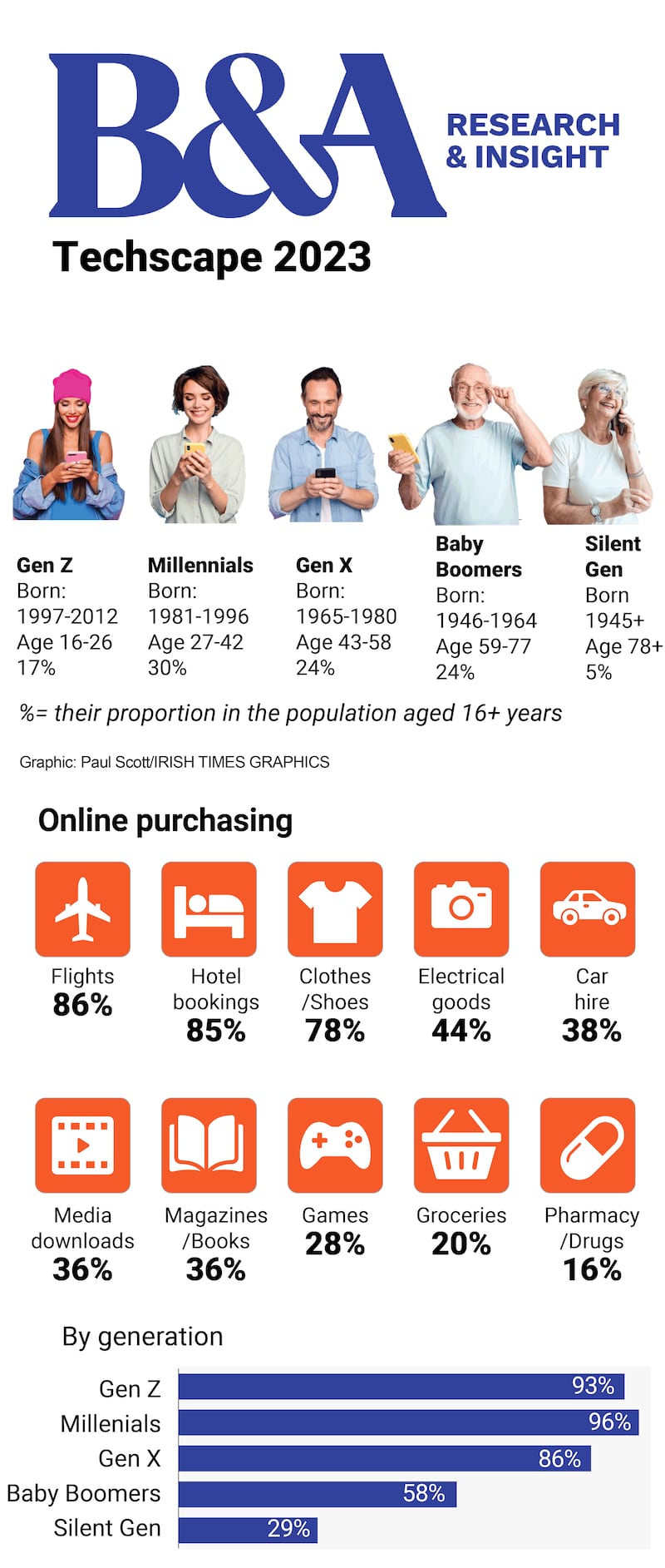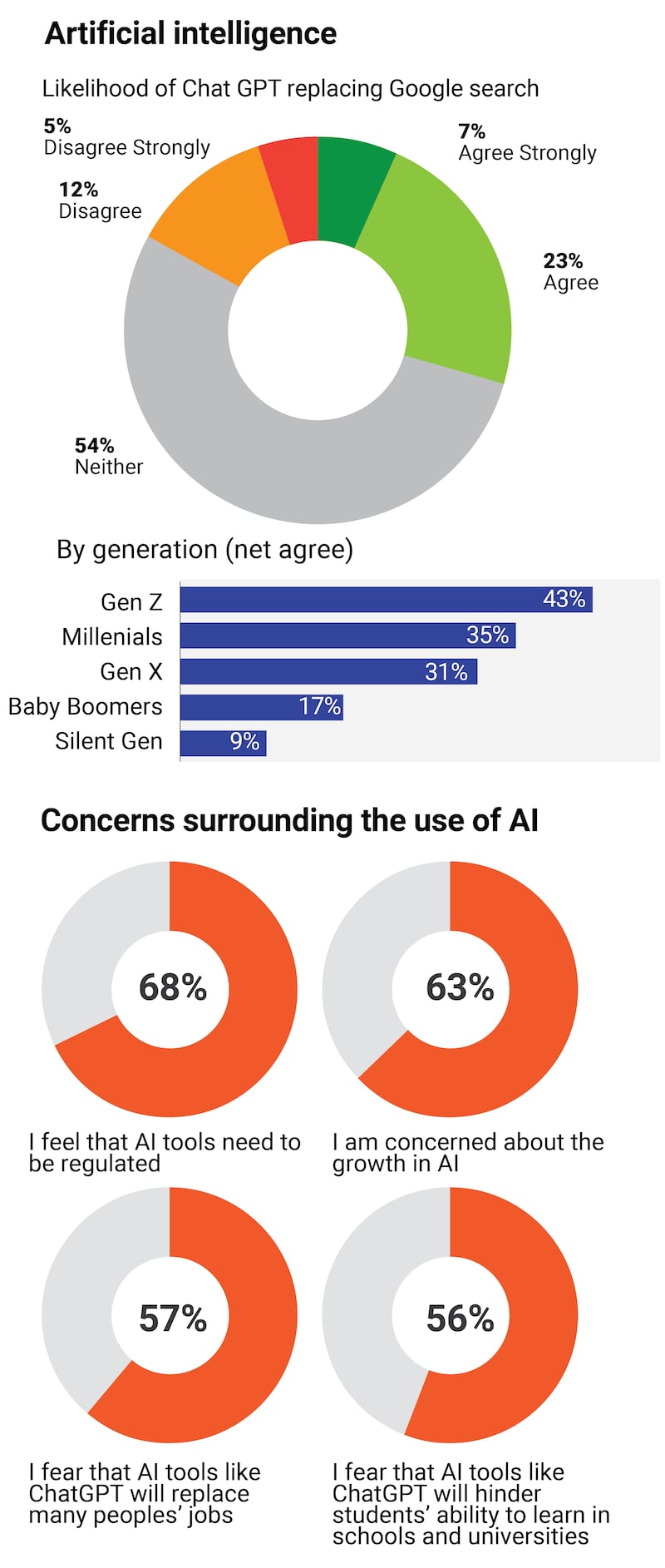Irish people are hugely reliant on technology to function, according to a new report, with 44 per cent believing technology is having a negative impact on family life in the home.
Commenting on the findings of the Behaviour and Attitudes (B&A) report, Techscape 2023, B&A managing director Luke Reaper said: “One of the most striking [implications of digitalisation] is the reliance on broadband, and joking aside, if someone ever switched it off, what would the world do?”
Through research conducted via face-to-face interviews with a sample of 1,000 people in Ireland above the age of 16, B&A found 85 per cent access the internet once a day or more often, with a widening divide between middle-class (95 per cent) and working-class (77 per cent) cohorts.
“Technology, by its very nature, has always been pushing boundaries and has expanded its reach into our lives, so much so that we now simply could not leave our homes without our smartphones,” the report said.
“At this stage, we are hugely reliant on technology to function as a human race, from entertainment right through to life administration (banking, communication, shopping, etc). From the minute we wake up we are immersed in a tech world. The dopamine hits we receive from our social media accounts are addictive. Technology will become ever more pervasive in our lives.”
The survey results show how society is turning more and more towards smart devices for day-to-day life – and the knock-on effects are not all positive.
It found tech ownership has again increased over the past year and has exacerbated existing concerns over its impact on family life. Three out of four rely on instant messaging apps such as WhatsApp for communication. Among Gen Z, which B&A give an age range of 16-26 years old, 90 per cent use WhatsApp and 75 per cent use Snapchat.
Seventy-four per cent of Gen Z said broadband was more important to them than TV, and most young people are watching more content on YouTube nowadays, the report found.

Virtually everyone below the age of 60 owns a smartphone and Irish homes have an average of eight smart devices such as a laptops, smartphones, eReaders or wearable devices (a Fitbit, for example).
The use of streaming services has increased rapidly. In recent years streaming giant Netflix has seen fierce competition join the market, and although the likes of Disney+ and Amazon Prime have increased their share usership in recent years (35 per cent and 38 per cent respectively), Netflix has continued to grow with 76 per cent of the population using the service.

More than 1.7 million consumers now use digital financial providers in Ireland, such as Revolut, up more than 10 per cent since last year. This is mostly dominated by younger people of a higher socioeconomic status.
Irish people are buying more online too. Eighty-one per cent purchase things online now, an increase of 6 per cent on 2022, and 15 per cent do their grocery shop online, the bulk of them being middle-class Dubliners.
One in five are buying products endorsed by influencers, but this increased to almost one in two among Gen Z consumers, highlighting the power online role models have on young people today.
There is a “clear divide” on tech usage between social classes in Ireland, the report said. One in four are working from home to some degree, and the report said while the practice “isn’t going anywhere ... it is a middle class, Dublin phenomenon”.
Surely, history cannot repeat itself with AI. We have been warned
When analysing work from home practices between social classes, 41 per cent of those in categories A, B and C1 (middle class) worked from home to some extent, compared with just 7 per cent of those in social classes C2, D and E (’blue collar’). The practice is more than twice as common in Dublin than in rural areas.
While the tech ownership gap between social classes has reduced from a 72 per cent difference in 2022 to a 52 per cent difference today, middle class consumers in Dublin continue to own the most tech.

When analysing work from home practices between social classes, 41 per cent of those in categories A, B and C1 (middle class) worked from home to some extent, compared with just 7 per cent of those in social classes C2, D and E (blue collar). The practice is also more than twiceb as common in Dublin than in rural areas. due to bluetechnology.
Half are checking emails, texts, social media first thing in the morning or last thing at night and 30 per cent said they check work emails when on holidays compared to 24 per cent in 2018. “Perhaps worryingly,” the report notes, one quarter of us are using apps to help meditate, relax or disconnect from the world. It’s no wonder seven in 10 feel we have lost the art of conversation, up 2 per cent on last year.
“The accessibility of technology and its addictive nature is a concern,” said Reaper, “especially for family life, and indeed the ‘always-on’ nature of today’s society. While we know these negatives, the dopamine hits we receive from usage make it impossible to self-regulate.”
The saturation of tech in our lives has led to a growing desire for authenticity and more visual media among Gen Z. The use of online dating apps has decreased by 10 per cent on last year, now at one in five looking for love online. Eleven per cent fewer people are following brands on social media, now at 68 per cent.
We simply do not fully understand the seemingly limitless power of AI and the possible impact this will have
The kind of apps young people aged 16-24 years old spend their time on are changing: 2 per cent less on Instagram this year, 13 per cent more on TikTok (79 per cent in total) and 11 per cent are now using BeReal, an app that encourages users to share a photo of themselves and their immediate surroundings in a randomly selected two-minute window every day.
“The move towards more visual social media at the expense of the written word has challenges going forward,” said Reaper. As Ireland continues to digitalise, the report said we must be mindful that just three in 10 of those over the age of 65 do not access the internet.
The survey was “carried out against the backdrop of the ChatGPT and AI explosion”, it said, and fears over artificial intelligence (AI) have proved widespread. About one in 10 (355,000 people) have used ChatGPT, a popular AI chatbot release last November. With all the media attention that accompanied its launch, most tried ChatGPT out of curiosity, but 36 per cent used it for work and 28 per cent asked it to help them with educational assignments.

The report said while AI has the potential to improve services such as healthcare, it may also “disrupt society and lives”, and suggested the judiciary must play a vital role in regulating AI moving forward.
“We simply do not fully understand the seemingly limitless power of AI and the possible impact this will have on our day-to-day lives,” it said. “It does seem that the public has been tuning into the warnings with two in three agreeing that they are concerned about AI and feel it should be regulated.”
The report said social media companies such as Facebook “have been left relatively unchecked, allowing for tech companies to expand their reach and influence in our lives. We didn’t realise social media’s power until it was too late.”
“Surely, history cannot repeat itself with AI,” the report concluded. “We have been warned.”

















